New ClayMates who came from the metalclay group:
Color, the new frontier for all y'all with polymer clay.
Here's a link that might help:
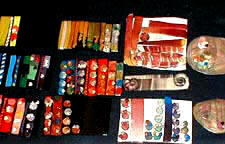
http://www.norajean.com/Biz-Archive/ColorCards/MainGroup.htm
Check out this page in particular if you're new to polymer clay
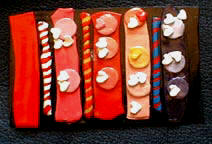
http://www.norajean.com/Biz-Archive/ColorCards/Samples/Card-002.htm
This is a color card for the color red.
Let's look at this from the left going to the right.
The size of this color card is smaller than a playing card. A half dozen
of
these will fit into an Altoid Tin.
The card is made of black clay that had been cured (heat set) but
without a
finish on it.
Take a small amount of red clay, condition it (I'll post a separate post
about
conditioning later), roll out a thin ribbon and put it on the left side
of the
card.
Take a snake of red and a snake of white and twist them like a candy
cane and
lay that under the pure red ribbon.
Mix equal amounts of red and white for a pink hue. To get an equal
amount roll out the clay and
use a standard cutting tool. A plastic soda straw will do in a pinch.
If you don't have a pasta machine to roll out the clay, stack playing
cards in two towers - 5-10 cards depending on how thick you want the
sheet, and roll over your
clay with a clean recycled glass jar from your kitchen. That's what
I did for the first couple of years before I bought a pasta machine.
Ok so we have this half white and half red hue. The half/half mix is
what I
refer to as the "base" secondary color.
Yellow, Red, Blue are the primary colors.
When they are mixed they make secondary colors.
When white is added to anything it make a pastel.
When translucent is added to anything it dilutes the hue, that's how we
get gem stone and lemonade,
more on that later.
Ok, so the half red and half white mix got us the base pink.
See the circles with the little white hearts on them, they are on top of
the
ribbon of the base pink?
Those circles are - base pink + rations of white. The first is base pink
with
two rations of white. The second is base pink with three rations of
white.
Now we make a candy cane of red and yellow straight out of the package.
We mix them to get a base orange.
The circles are
base orange with one ration of white
base orange with two rations of white
base orange with a ration of base pink and that will give you peach... a
most
lovely color.
The next row is a ribbon made of base pink with two rations of white,
one ration of yellow to get
the ribbon of Barbie Flesh Caucasian. The last circle on that Barbie
Flesh Caucasian ribbon is BFC with one ration of red and another ration of
white and it looks like 50/50 popcicle orange. Not all mixes are happy
ones.
The next candy cane is red and blue straight out of the pack.
The base purple is the ribbon. The circles are
base purple with one ration of white
base purple with two rations of white
base purple with three rations of white.
You see where I'm going with this don't you? Now that we have red mixed
with
yellow and blue, adding white to see what the pastel ratios are, we cure
this
card and splash it with some acrylic floor polish.
Now we do the same thing to blue
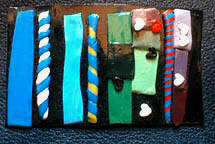
http://www.norajean.com/Biz-Archive/ColorCards/Samples/Card-003.htm
and to yellow
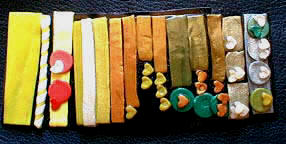
http://www.norajean.com/Biz-Archive/ColorCards/Samples/Card-004.htm
But note ... the yellow card looks different. Since we already mixed red
with
yellow and blue with yellow, to do that again for the yellow color card
would be
totally boring.
I mixed yellow with pearl, silver, gold. Now we're getting some
interesting
hues.
You metalclay folks would love the mica polymer clay colors:
Pearl
Silver
Gold
Copper
which you can use straight out of the pack or you can mix with other
primary or secondary colors
to get some unique hues.
Now why would I be suggesting that you do the color card exercise?
Because I
don't want you to waste clay.
Let me digress with a little tale of melted cheddar cheese.
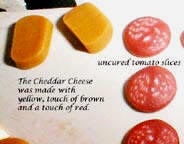
http://www.norajean.com/Biz-Archive/food/burgerNfries/CheeseBurger-004.htm
Long time ago I made these mini cheese burgers and accidentally stumbled
across the mix for melted
cheddar cheese. It was just magically delicious. I made a double
fist full before I got the mix right. It took a couple of years of using this
melted cheddar cheese mix and giving chunks of it away when I was on
tour to use it up.
In the mean time I found that melted cheddar cheese mix was great as
"Toasty
Top" on miniature baked goods.
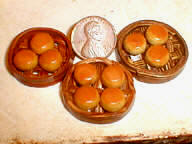
http://www.norajean.com/Food/ToastyTop/11-17-05-RollsBuns-003.htm
Time came to make it again and I was stumped. I didn't leave a crumb
trail for
myself to follow to make it again without using up a ton of clay, which
I didn't
want to do again. I was sweating bullets. I wanted more melted cheddar
cheese mix but I didn't want
to waste clay...then I flashed... Color Cards!
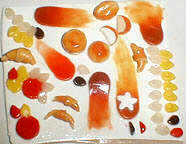
http://www.norajean.com/Food/ToastyTop/Index.htm
That section is my exploration of Toasty Top mix, aka melted cheddar
cheese, and this time I'm
leaving a crumb trail for me to follow. In the process I
discovered pumpkin pie hue, a base for spaghetti sauce, and other hues.
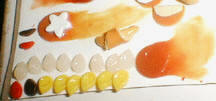
http://www.norajean.com/Food/ToastyTop/005.htm
When I found the hue I wanted I put a big white star on it.
You see that with the Toasty Top mix I did a "smear" of the mixes.
That's
because to make miniature baked goods with the toasty top I smear the
mix down the side of the
baked item to get that toasty look.
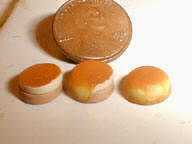
http://www.norajean.com/Food/ToastyTop/Bikkies-005.htm
Now you're probably saying "I have no plans on making miniature food."
Not now maybe but you might
not be thinking how fun sushi earrings may be.
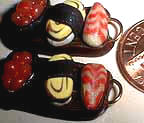
http://www.norajean.com/Biz-Archive/food/Sushi/Sushi-Jewelry-004.htm
or watermelon earrings
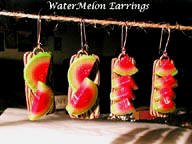
http://www.norajean.com/Biz-Archive/food/food-watermelon-009.htm
miniature food can be put on covered pens, covered tins, pins, earrings,
cufflinks. They are not limited to dolls houses.
But the challenge with doing miniature food is getting the color correct
and
remembering.....
translucent clay = water
like with peeled oranges
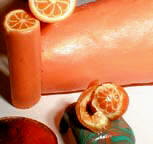
http://www.norajean.com/Biz-Archive/food/Citrus/2002-orange-grp.htm
if some mini food has water in it in real life then you best be looking
at
translucent clay.
Now what about liquid translucent clay? Oh we now can do whipped cream
and chocolate sauce. TLS is
Translucent Liquid Sculpey, but there are other brands.
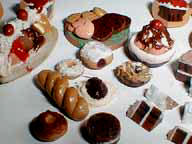
http://www.norajean.com/Biz-Archive/food/TLSastries/Group-TLSastriesThms.htm
With liquid translucent polymer clay you can make marmalade and jam
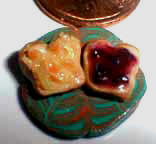
Ah but I digress, as is my wont to do...
I encourage all new clayers to make color cards, exhaust the
possibilities of
mixing colors and have your ratios on hand to replicate a color you
needed.
Don't even make me tell you about the mound of martini olive I ended up
with
when I only need a booger's worth of that color mix. Jeese Louise! ;-)
Lastly, in order to have your polymer clay creations be uniquely yours
please
find the color hues that brighten up your heart. I happen to like green
with a
touch of gold. That's my preference because I'm a Leo and I pause for
shiny and
glittery things. Someone else, a Scorpio perhaps, might want their green
to have
more blue in it, to be more mysterious.
Anyone can use clay straight out of the pack and when they do it looks
like it.
But when you mix your own colors you limit the amount of colors you need
to buy
to a dozen:
white
black
translucent
zinc yellow
cobalt blue
cadmium red
burnt umber
raw sienna
pearl
gold
silver
copper
You never need to buy secondary colors or pastels because you can mix
them. When
you limit the colors you buy because you're a mixing maven then you can
buy
polymer clay by the pound and get the discount from buying in bulk.
Now you know we don't advertise in this group, there is one exception:
http://www.clayalley.com
Karen Rhodes and her partner Donna have been serving this group for over
10
years. We started out together. In fact she started buying clay for us
wholesale
and sharing the
savings before she started her business of ClayAlley. She has
been
more than generous over the years with donations to clayers in need and
donating
products for our Newbie Boxes (in hiatus due to computer problems with
a
volunteer).
Karen has sent clay to South Africa, no jive, and South America, as well
as all
around the Europe and the United Kingdom. She has a great assortment of
tools as
well as clay.
I prefer Premo. That's my preference because Fimo is too hard on my
hands.
I like that Premo uses standard colors like zinc yellow and cobalt blue.
Some
other clay manufacturers have their "brown" but it's not burnt umber or
raw
sienna and I come from a classically trained art background and generic
brown
ain't going to make
good miniature chocolate, not like Premo burnt umber will... Yummy
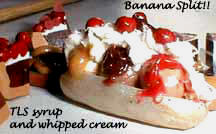
http://www.norajean.com/Biz-Archive/food/TLSastries/001-BananaSplit.htm
I think I'll save this post as a Ramble because I've been wanting to
write a color mixing ramble for a while.
Ok, my brain is emptied at the present time so I'll send this off.
xoxo
NJ
